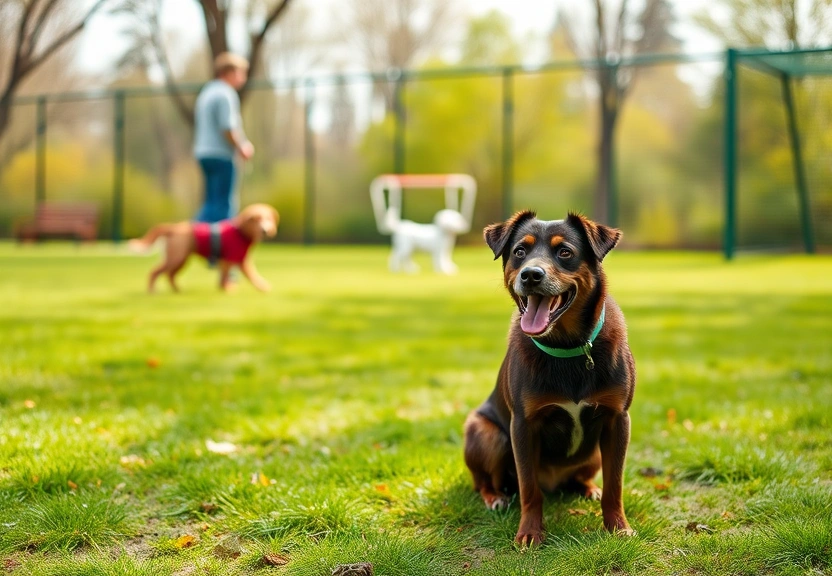Contents
ToggleRevolutionizing Dog Parks: Innovative Spaces for Our Beloved Pups to Play
We all know our dogs aren’t just pets; they’re family. We celebrate their birthdays, spoil them with toys and treats, arrange playdates, and even let them hog the bed. We pull out our phones to show off photos like proud parents. Our bond with them runs deep, and yet, when it comes to their playtime, many parks often fall short of providing the stimulating and engaging environments that our beloved pups deserve. This is where the concept of innovative dog parks comes into play.

As urbanization increases and the demand for pet-friendly spaces rises, cities are beginning to rethink traditional dog parks. Innovative play spaces are being designed not only to cater to the physical needs of dogs but also to enhance their social interactions, mental stimulation, and overall well-being. This article will explore how these modern dog parks are revolutionizing canine socialization and fostering a sense of community among dog owners.
The Importance of Dog Parks in Modern Society
Dog parks serve as essential communal spaces where dogs can exercise, socialize, and play freely. With the growing number of pet owners, these parks have become vital for promoting a healthy lifestyle for both dogs and their owners. The benefits of dog parks include:
- Physical Exercise: Dogs require regular exercise to maintain their health and happiness. Dog parks provide ample space for them to run, play, and engage in physical activities.
- Socialization: Interacting with other dogs helps prevent behavioral issues and fosters a well-adjusted pet.
- Community Building: Dog parks serve as social hubs where dog owners can connect, share experiences, and build friendships.
- Mental Stimulation: Innovative dog parks incorporate various features that challenge dogs mentally, promoting cognitive development.
🎥 Assista esta análise especializada sobre Revolutionizing Dog Parks: Innovative Spaces for Our Beloved Pups to Play
Designing Innovative Dog Parks
As we venture into the future of dog parks, it’s crucial to focus on innovative designs that prioritize both pet and owner experiences. Here are some key elements that make dog parks more engaging and beneficial:
1. Varied Play Zones
Instead of a one-size-fits-all approach, modern dog parks are featuring varied play zones tailored to different dog sizes, energy levels, and temperaments. Areas might include:
- Small Dog Areas: A separate enclosed space for smaller breeds to play safely without the risk of larger dogs overwhelming them.
- Agility Courses: Obstacle courses designed to challenge dogs physically and mentally, enhancing their agility and obedience.
- Quiet Zones: Spaces for dogs that may feel overwhelmed, providing a calm environment for relaxation.
2. Pet-Friendly Design Elements
Innovative dog parks are increasingly incorporating pet-friendly design elements that focus on safety and comfort:
- Natural Landscaping: Incorporating native plants and natural materials can create a more inviting and stimulating environment.
- Water Features: Splash pads or ponds can provide dogs with a refreshing way to cool off during warmer months.
- Shade Structures: Providing shaded areas to protect dogs and their owners from the sun while they play.
3. Technology Integration
As technology becomes more integrated into our daily lives, innovative dog parks are embracing it to enhance the user experience:
- Dog Park Apps: Mobile applications that allow dog owners to check park conditions, schedule playdates, and connect with other local dog owners.
- Live Cameras: Streaming live footage of the park, enabling owners to monitor their pets remotely.
- Automated Waste Disposal: Smart waste bins that alert maintenance when they need to be emptied, keeping the park clean and hygienic.
Promoting Canine Socialization
Effective canine socialization is critical for a well-rounded pet. Innovative dog parks can play a pivotal role in this process:
1. Structured Playdates and Events
Many modern dog parks host structured playdates, training sessions, and community events aimed at promoting socialization. These events can include:
- Training Workshops: Sessions led by professional trainers to help owners teach their dogs essential social skills.
- Socialization Days: Organized meet-ups for dogs of similar sizes and temperaments to encourage safe interactions.
- Dog Friendly Events: Seasonal events that bring together dog owners for fun activities, fostering community spirit.
2. Safe Interaction Guidelines
To ensure safety and positive interactions, innovative dog parks are implementing clear guidelines:
- Owner Education: Providing resources on how to read dog body language and intervene when necessary.
- Leash Policies: Enforcing leash laws in certain areas to maintain order and safety.
- Behavioral Monitoring: Staff or volunteers trained to monitor interactions and step in if conflicts arise.
Building a Dog Owner Community
Beyond the physical space, innovative dog parks aim to build a sense of community among dog owners:
1. Community Engagement
Dog parks can serve as community hubs where dog owners come together:
- Volunteer Programs: Opportunities for owners to get involved in maintaining the park and organizing events.
- Local Partnerships: Collaborating with local pet businesses for sponsorships, events, and promotions.
- Feedback Mechanisms: Encouraging users to provide input on park design and management to better meet community needs.
2. Educational Resources
Innovative dog parks can offer educational materials and programs to empower dog owners:
- Workshops on Dog Health: Sessions covering topics such as nutrition, grooming, and healthcare.
- Behavioral Seminars: Expert-led discussions on addressing common behavioral issues.
- Networking Opportunities: Creating spaces for dog owners to share experiences and advice.
Frequently Asked Questions (FAQs)
1. What makes an innovative dog park different from a traditional one?
Innovative dog parks incorporate varied play zones, pet-friendly design elements, and technology to enhance the experience for both dogs and owners, promoting safety, socialization, and community building.
2. How can I find an innovative dog park near me?
Search online directories, local community boards, or pet-related apps that provide information on dog parks in your area. Websites dedicated to pet-friendly spaces often have user ratings and reviews.
3. What should I bring to an innovative dog park?
Essential items include your dog’s leash, waste bags, water, treats, and any toys your dog enjoys. Additionally, consider bringing a portable water bowl and shade for hot days.
4. Are there any rules I should follow at a dog park?
Always follow posted park rules, keep your dog on a leash until in the designated area, clean up after your pet, and supervise your dog closely. Understanding dog body language is crucial to ensuring a safe environment.
5. How can I get involved in my local dog park community?
Participate in events, volunteer for park maintenance, attend workshops, or join social media groups dedicated to local dog owners. This is an excellent way to connect with fellow dog enthusiasts and contribute to the community.
Conclusion
As our understanding of canine needs evolves, so too must the spaces we create for them. Innovative dog parks are not just a trend; they represent a significant shift toward prioritizing our pets’ physical, mental, and social well-being. By embracing advanced design concepts, community engagement, and educational resources, we can ensure that our dogs have the best possible environments to thrive. The future of dog parks looks bright, and as responsible pet owners, we can play a pivotal role in shaping these spaces to enhance the lives of our beloved pups and strengthen the bonds within our dog owner community.
📰 Original Source
Este artigo foi baseado em informações de: https://www.dogster.com/lifestyle/redesigning-dog-parks-a-new-way-for-pups-to-play





